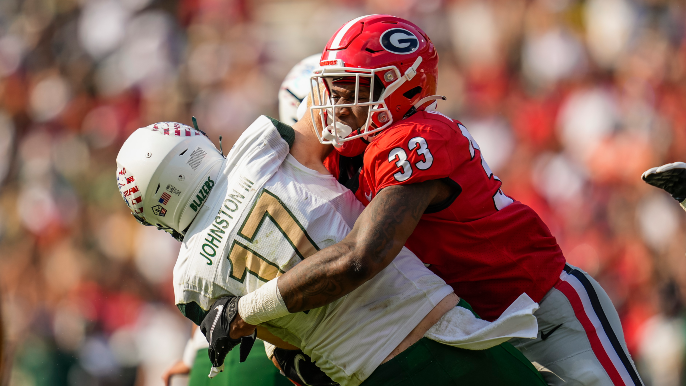
It seems nearly every year, the reaction to the 49ers’ draft class is “ehh.”
While teams like the Eagles, Giants, Cardinals and others received high praise for drafting athletic prospects with high-level college production, the 49ers made some selections that left folks scratching their heads.
Did they fail to address their needs? Are they leaning too much on veteran, one-year free agent signings? A kicker in the third?!?
We’ll try and answer all those questions, starting with their first selection.
*Trade up* Round 3, Pick 87: Ji’ayir Brown, S, Penn State
Trade details
- 49ers received: Pick 87
- Vikings received: Picks 102, 164, and 222
Lots of people who have watched a lot more tape than I are very high on Brown. He’s flashed a nose for the ball in college and reports suggest his coverage instincts are solid.
Some of the most prominent college evaluators have him as their top safety. There is a lot to like, and plays a lot faster than his testing would suggest. The 49ers expressed a good deal of confidence that he’s more athletic than his testing showed.
That said, it’s not extremely encouraging. It’s also not damning, either:
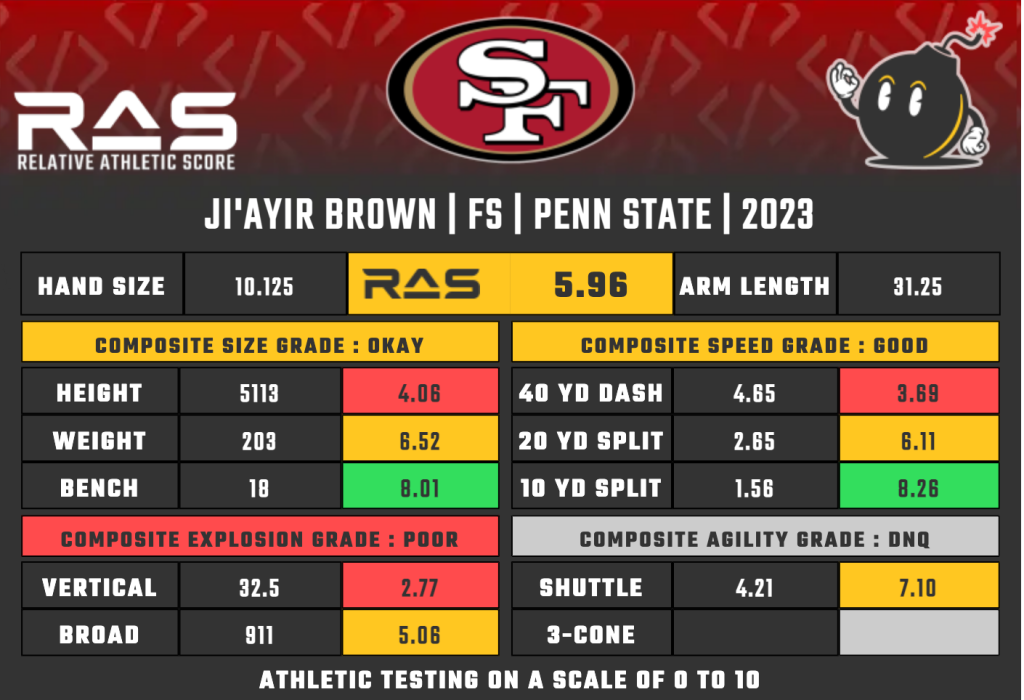
Safety, despite having Talanoa Hufanga (still with major question marks in coverage) and Tashaun Gipson Sr. (about to be 33 and considered retirement), was a need.
Brown is not necessarily expected to win the starting job, but he could see playtime in three-safety packages, which the 49ers have used a fair amount.
While betting on athleticism is generally a sound bet, safety is an extremely difficult position to evaluate, and coverage instincts and intelligence there are higher priorities than pure athleticism, unless you’re strictly an in-the-box safety.
The 49ers had a lot of picks to burn and a need at safety. Moving up for a player of Brown’s caliber is solid value and a pick worth being excited about.
Round 3, Pick 99: Jake Moody, K, Michigan
This is the one that has everyone’s head spinning. And on one level, I get it. It’s a kicker in the third round.
Didn’t you need a tackle? A defensive end? Couldn’t you have traded back and still got a kicker?
All fair questions. The thing is, there was one kicker in this draft, from the 49ers’ perspective, worth taking. It’s Moody. There are other teams, like the Packers and Cowboys, who are desperate for a kicker.
The top kicking prospect usually comes off the board in the fourth. San Francisco didn’t have a fourth-round pick, and if they traded back, there’s a risk they could have missed their chance. With a situation like this, where — as Kyle Shanahan stated — it is your only position of need for a starter, you can’t really mess around and try and get a little extra value.
If they had traded down and lost Moody by trying to close the gap to their next pick, it would’ve been a catastrophic failure. The next kicker, Maryland’s Chad Ryland, went just 13 picks later.
Now, it will look like a catastrophic failure if Moody doesn’t succeed, but he’s solid. He made the longest field goal in CFP history, from 59 yards, and was reliable in clutch situations for Michigan.
If he was drafted in the fourth instead of the third, people wouldn’t be shaking their head nearly as much. But this is basically an early fourth-round pick. The optics of it being a true third-round pick are a little silly. That said, this one stings more because of the next selection.
Round 3, Pick 101: Cam Latu, TE, Alabmaa
I don’t get this at all. Of the tight ends I watched, Latu was my least favorite. His blocking ability was poor. He seemed to consistently get pushed back or straightened at the point of contact. Others showed an ability to drive on tape. He did not.
His receiving ability has real upside and he does have encouraging athleticism, though that doesn’t always jump off the tape.
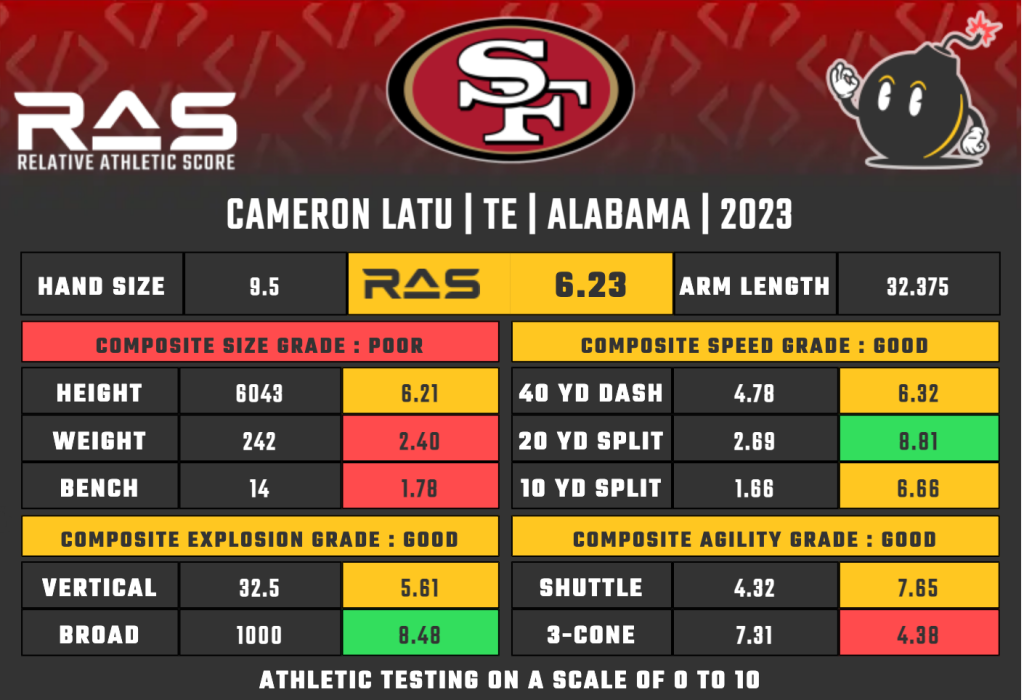
There were other prospects who were better blockers out of the gate with receiving upside, like Cincinnati’s Josh Whyle, Purdue’s Payne Durham and Wake Forest’s Blake Whiteheart. The first two on that shortlist went in the fifth round. Whiteheart went undrafted.
There were also other high-quality receiving tight ends with more athleticism than Latu who were poor blockers on tape, like Clemson’s Davis Allen and Will Mallory.
The most confounding part of the selection was the fact that the 49ers had a 54-pick gap to their next selection and there were a number of names on the board who were probably better fits, or at least more valuable than Latu.
There were a ton of trades up at the start of the fourth round, when a number of highly-rated prospects came off the board.
When you have potential starting-caliber corner available at this pick in Georgia’s Kelee Ringo, a potential starting-caliber tackle (projected to go in the second round) in Ohio State’s Dawand Jones and a hyper-athletic, potential starting tackle in Old Dominion’s Nick Saldiveri all available, it’s hard to wrap your head around this.
That said, there’s this blurb from Albert Breer:
Saldiveri, though? He went with the first pick of the fourth round. Ringo? The third pick of the fourth round. Both of those picks were traded up for by the Saints and Eagles. The pick in between was athletic corner prospect Jakorian Bennett, selected by the Raiders.
The rest of the run of players after Latu was drafted makes the selection all the more head-scratching.
If Latu was a freaky athlete or showed something on tape to make you go “wow, this guy is going to be a problem,” it would be more understandable. San Francisco needed another tight end, I’m just not confident this is the one they should have drafted, or that they got good value with the other players available at this spot.
This is probably an overreaction given other, cheaper tight end prospects, the ability to trade down, and other, more valuable positions available.
Round 5, Pick 155: Darrell Luter Jr., CB, South Alabama
This is the point in the draft where you’re mostly lying or just deeply committed to college football if you’re well-versed in members of the secondary.
College football tape is already difficult to come by, let alone All-22, which shows you what actually goes down in the secondary.
That said, Luter Jr. has a great frame and major athletic upside.
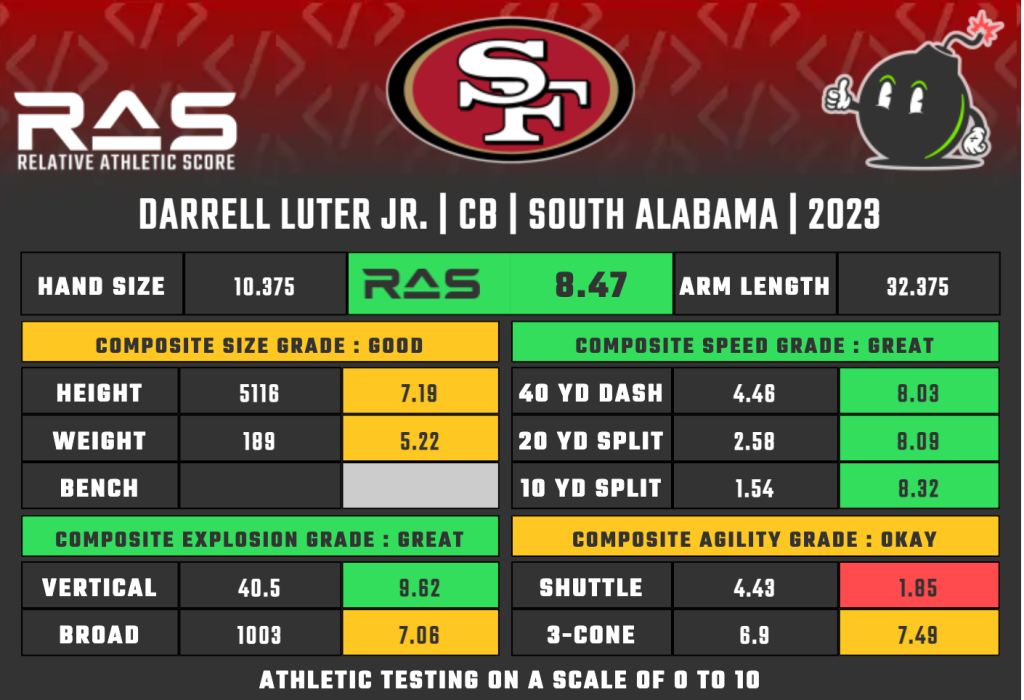
He’s got very long arms and flashes an ability to play through the ball, attacking it at the catch point. A lot of the 49ers’ failed corner picks, like Ahkello Witherspoon, struggled in that regard.
At this stage, there’s little to dislike about the selection.
Round 5, Pick 173: Robert Beal Jr., EDGE, Georgia
The fifth round has long been the 49ers’ sweet spot, and these two picks, at least from the outset, look like they have the makings of success.
Beal Jr. is a guy who was a rotation pass-rusher at Georgia, but had to take on some linebacker responsibilities. John Lynch said Georgia head coach Kirby Smart told the 49ers he’s a guy who will thrive if he’s allowed to fly off the edge and get after the quarterback.
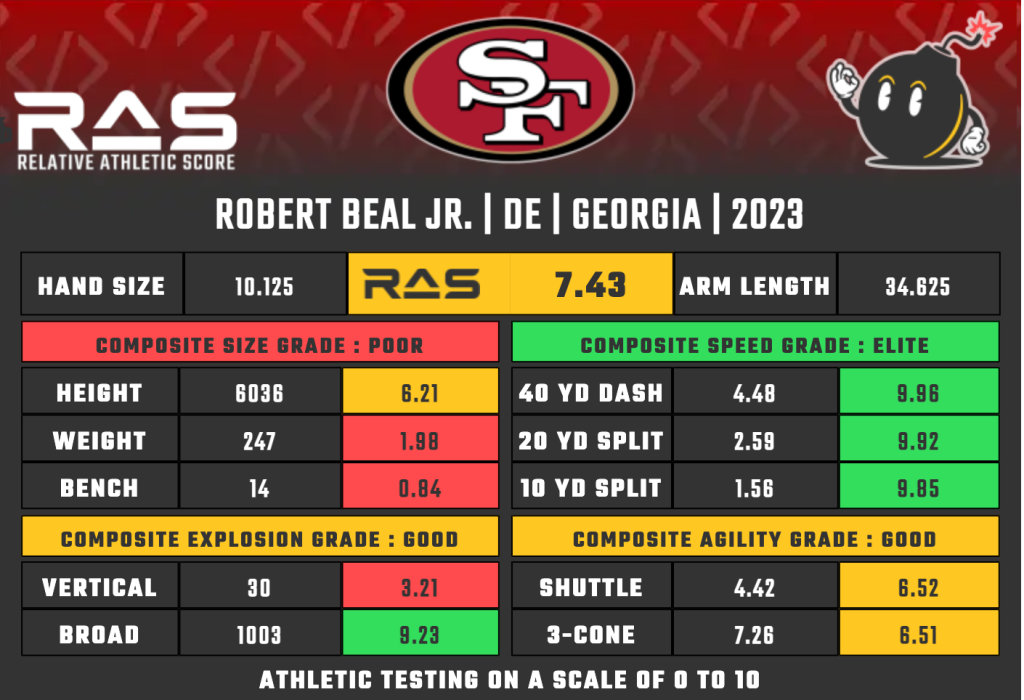
It’s hard to think of a better type of player to give to defensive line coach Kris Kocurek. The 49ers lost Arden Key and Charles Omenihu (Samson Ebukam, too) over the past two seasons. Beal Jr. has that same sort of lengthy, long-armed athletic mold where it’s not hard to envision him stunting inside or rushing from an upright position like Key and Omenihu often did.
Production at the stage of the draft isn’t all that consequential. Beal Jr. had 9 sacks in his final two season at Georgia, when he was heavily involved in the pass rush rotation. He’s a very good bet at this stage of the draft.
Round 6, Pick 216: Dee Winters, LB, TCU
With the 49ers losing Azeez Al-Shaair, there’s a clear opening at SAM linebacker. While they have Oren Burks and some other young names like Curtis Robinson, Marcelino McCrary-Ball and Demetrius Flannigan-Fowles, none of those last three inspire much confidence.
Burks was brought in for more of a special teams role than to be an outside linebacker, and Winters can fly.
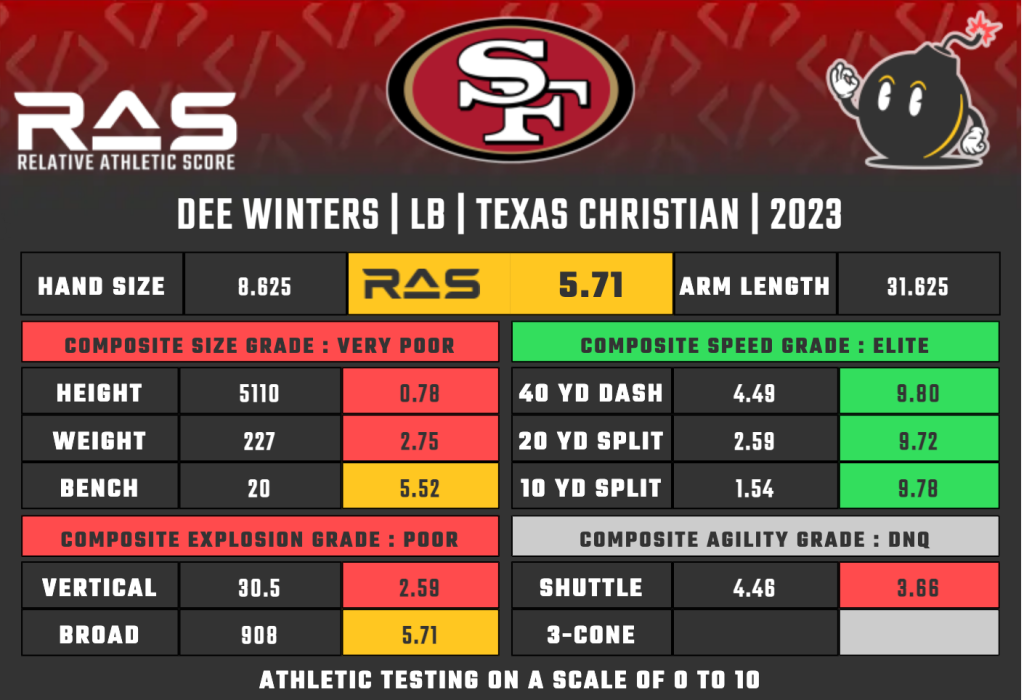
His production against Michigan in the national semifinal was outrageous, racking up 7 tackles, 3.0 for a loss, a pass breakup and a 29-yard pick-six.
Winters was one of the leaders of the TCU defense and while he’s a little undersized, the speed and determination to get to the ball is evident. He had 79 tackles, 14.5 for a loss, 7.5 sacks and a pick-six in his senior season.
If he can compensate for his lack of size, he might be a steal, or at least a potentially great gunner early on in his career.
Round 7 picks
Round 7, Pick 247: Brayden Willis, TE, Oklahoma
These are all grouped together because you can’t really go wrong in the seventh round. That said, the 49ers have hit on a shocking amount of their seventh-round picks.
In the Shanahan-Lynch regime, the 49ers have drafted the following players in the seventh round: Brock Purdy, Jauan Jennings, Richie James Jr., Adrian Colbert.
Colbert was the worst of those selections and the 49ers still got some decent production out of him for a while. That’s not a miss this late in the draft.
This year’s selections have a lot to like. Willis is a more intriguing tight end than Latu is. He played wildcat quarterback, fullback and tight end at Oklahoma and flashed some really compelling traits. He also made this absolutely insane catch:
His athletic testing is underwhelming, by that’s why he was available here in the seventh round. He’s one to watch in training camp, especially against the likes of Charlie Woerner and Ross Dwelley.
Round 7, Pick 253: Ronnie Bell, WR, Michigan
As for the next guy on this list, Ronnie Bell, there’s also quite a bit to like. He’s undersized at a tick under six feet tall, but he’s incredibly athletic and offered a ton of production to Michigan in his senior season (62 receptions, 889 yards, 4 TDs). Why not?
Round 7, Pick 255: Jalen Graham, LB, Purdue
Another linebacker with nearly the final pick of the draft. Graham tested terribly in every area but speed, so he’s essentially a special teams prospect. Maybe he’s a decent gunner. It’s pick 255. Go for it, Lynch.

